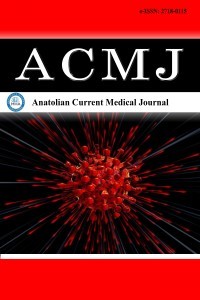1.
Fleischmann C, Scherag A, Adhikari NKJ, et al. Assessment of global incidence and mortality of hospital treated sepsis current. Estimates and limitations. Am J Respir Crit Care Med 2016;193(3):259-272. doi:10.1164/rccm.201504-0781OC
2.
Li S, Guo B, Chen H, et al. The role of the triglyceride (triacylglycerol) glucose index in the development of cardiovascular events: a retrospective cohort analysis. Sci Rep. 2019;9(1):7320. doi:10.1038/s 41598-019-43776-5
3.
Hunter SJ, Garvey WT. Insulin action and insulin resistance: diseases involving defects in insulin receptors, signal transduction, and the glucose transport effector system. Am J Med. 1998;105(4):331-345. doi: 10.1016/s0002-9343(98)00300-3
4.
Ginsberg HN. Insulin resistance and cardiovascular disease. J Clin Investig. 2000;106(4):453-458. doi:10.1172/jci10762
5.
Yin JL, Yang J, Song XJ, et al. Triglyceride-glucose index and health outcomes: an umbrella review of systematic reviews with meta-analyses of observational studies.Cardiovasc Diabetol. 2024;23(1):177. doi:10. 1186/s12933-024-02241-y
6.
Behnoush AH, Mousavi A, Ghondaghsaz E, Shojaei S, Cannavo A, Khalaji A. The importance of assessing the triglyceride-glucose index (TyG) in patients with depression: a systematic review.Neurosci Biobehav Rev. 2024;159:105582. doi:10.1016/j.neubiorev.2024.105582
7.
Fang Y, Xiong B, Shang X, et al. Triglyceride-glucose index predicts sepsis-associated acute kidney injury and length of stay in sepsis: a MIMIC-IV cohort study. Heliyon. 2024;10(7):e29257. doi:10.1016/j.heliyon.2024.e29257
8.
Zheng R, Qian S, Shi Y, Lou C, Xu H, Pan J. Association between triglyceride-glucose index and in-hospital mortality in critically ill patients with sepsis: analysis of the MIMIC-IV database.Cardiovasc Diabetol. 2023;22(1):307. doi:10.1186/s12933-023-02041-w
9.
Singer M, Deutschman CS, Seymour CW, et al. The third international consensus definitions for sepsis and septic shock (sepsis-3). JAMA. 2016; 315(8):801-810. doi:10.1001/jama.2016.0287
10.
Du T, Yuan G, Zhang M, Zhou X, Sun X, Yu X. Clinical usefulness of lipid ratios, visceral adiposity indicators, and the triglycerides and glucose index as risk markers of insulin resistance. Cardiovasc Diabetol. 2014;20(13):146. doi:10.1186/s12933-014-0146-3
11.
Wang J, Zhao H, Liu Q, Zhang M. Association between triglyceride-glucose index and ICU outcomes in septic patients. Cardiovasc Diabetol. 2023;22(1):89. doi:10.1186/s12933-023-01657-x
12.
Liao Y, Zhang R, Shi S, et al. Triglyceride-glucose index linked to all-cause mortality in critically ill patients: a cohort of 3026 patients. Cardiovasc Diabetol. 2022;21(1):128. doi:1186/s12933-022-01563-z.10
13.
Zhang Y, Li J, Tan W. Dynamic trajectories of the TyG index in critically ill patients. Critical Care Med. 2023;51(2):145-153. doi:10.1097/CCM. 0000000000005681
14.
Vermeer SE, Sandee W, Algra A, et al. Impaired glucose tolerance increases stroke risk in nondiabetic patients with transient ischemic attack or minor ischemic stroke. 2006;37(6):1413-1417. doi:10.1161/01.STR.0000221766.73692.0b
15.
Zhang P, Pan S, Yuan S, Shang Y, Shu H. Abnormal glucose metabolism in virus associated sepsis. Front Cell Infect Microbiol. 2023;13:1120769. doi:10.3389/fcimb.2023.1120769
16.
Muniyappa R, Sowers JR. Role of insulin resistance in endothelial dysfunction. Rev Endocr Metab Disord. 2013;14(1):5-12. doi:10.1007/s11154-012-9229-1
17.
van den Berghe G, Wouters P, Weekers F. Intensive insulin therapy in critically ill patients. N Engl J Med. 2001;345(19):1359-1367. doi:10.1056/NEJMoa011300
18.
Carlson GL. Insulin resistance and glucose-induced thermogenesis in critical illness. Proc Nutr Soc. 2001;60(3):381-388. doi:10.1079/pns200193
19.
Di Pino A, DeFronzo RA. Insulin resistance and atherosclerosis: implications for insulin-sensitizing agents. Endocr Rev. 2019;40(6):1447-1467. doi:10.1210/er.2018-00141
20.
Zhang S, Fan T, Wang L, Chen N, Ma L. Impact of the triglyceride-glucose index on 28-day mortality in non-diabetic critically Ill patients with sepsis: a retrospective cohort analysis.BMC Infect Dis. 2024;24(1): 785. doi:10.1186/s12879-024-09711-4
21.
Lou J, Xiang Z, Zhu X, et al. A retrospective study utilized MIMIC-IV database to explore the potential association between triglyceride-glucose index and mortality in critically ill patients with sepsis.Sci Rep. 2024;14(1):24081. doi:10.1038/s41598-024-75050-8
22.
Yang Y, Huang X, Wang Y, et. al. The impact of triglyceride-glucose index on ischemic stroke: a systematic review and meta-analysis. Cardiovasc Diabetol. 2023;22(1):2. doi:10.1186/s12933-022-01732-0
23.
Nayak SS, Kuriyakose D, Polisetty LD, et. al. Diagnostic and prognostic value of triglyceride glucose index: a comprehensive evaluation of meta-analysis. Cardiovasc Diabetol. 2024;23(1):310. doi:10.1186/s12933-024-02392-y
24.
Li X, Chen Y, Zhang L, Wang H. (2022). The predictive value of the triglyceride-glucose index for ICU mortality in sepsis. BMC Infect Dis. 2022;22(1):345. doi:10.1186/s12879-022-07345-4
25.
Rivas AM, Nugent K. Hyperglycemia, insulin, and insulin resistance in sepsis. Am J Med Sci. 2021;361(3):297-302. doi:10.1016/j.amjms.2020.11.007

